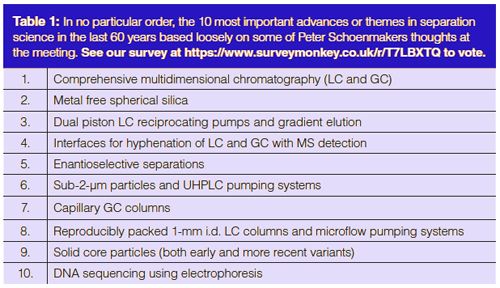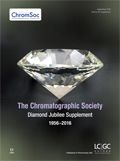Meeting Review: Advances in Microcolumn and Related Separation Technologies
Special Issues
The first meeting in The Chromatographic Society’s diamond anniversary year brought together world‑renowned speakers alongside past presidents of the Society, delegates from academia and industry, and scientific instrument and technology companies at the Institute of Engineering and Technology in central London on 22 March 2016. The presentations included discussions on liquid chromatography (LC), supercritical fluid chromatography (SFC), and gas chromatography (GC) from both an academic and industrial perspective - providing excellent insight into the state-of-the-art in these techniques for the delegates.
Paul Ferguson, President, The Chromatographic Society, UK.
The first meeting in The Chromatographic Society’s diamond anniversary year brought together worldârenowned speakers alongside past presidents of the Society, delegates from academia and industry, and scientific instrument and technology companies at the Institute of Engineering and Technology in central London on 22 March 2016. The presentations included discussions on liquid chromatography (LC), supercritical fluid chromatography (SFC), and gas chromatography (GC) from both an academic and industrial perspective - providing excellent insight into the state-of-the-art in these techniques for the delegates.
The Chromatographic Society’s Advances in Microcolumn and Related Separation Technologies was held at the Institute of Engineering and Technology (IET) on a beautiful Spring day in Savoy Place, in London, UK, overlooking the River Thames. There were over 130 attendees registered for the meeting including 14 vendor companies (including the principal meeting sponsors Agilent Technologies, Shimadzu, and Waters) presenting the latest from their product portfolios - all making for a vibrant atmosphere.
Some highlights included Ian Wilson’s presentation of high throughput ultrahigh-pressure liquid chromatography–mass spectrometry (UHPLC–MS) metabolic profiling; an insightful discussion on approaches for the analysis of thermally unstable analytes by gas chromatography (GC) by Pat Sandra; the diverse application of supercritical fluid chromatography (SFC) and SFC–MS - particularly of drugs of abuse in sports science - by Jean-Luc Veuthey; and a review of comprehensive multidimensional LC by Peter Schoenmakers, including his group’s work in 3D chromatography for separation of complex peptide samples. This work on 3D-LC is a major endeavour that the group is undertaking and comes under the acronym, STAMP (separation techniques for a million peaks).

One interesting aspect of Peter Schoenmakers presentation was his thoughts on the 10 most important breakthroughs in separation science in the last 60 years.
Other speakers included David McCalley, Frederic Lynen, Tom Lynch, Peter Myers, Guy Wilson, and Kevin van Geem.
As part of our celebrations, we would be interested in finding out what readers believe are the most important breakthroughs in separation science in the lifetime of The Chromatographic Society. Our proposals are listed in Table 1 and more information for our reasoning may be found on The Chromatographic Society website (www.chromsoc.com).
To this end we are conducting a short on-line poll to ascertain your views, which can be accessed through this link: https://www.surveymonkey.co.uk/r/T7LBXTQ. We will publish the result early next year in LCGC’s The Column and on the ChromSoc website. Please take two minutes to share your views. There is an “other” option where you can suggest an alternative if you don’t agree with what’s on our Top 10 list.
Paul Ferguson is the President of The Chromatographic Society.




















Sorbonne Researchers Develop Miniaturized GC Detector for VOC Analysis
April 16th 2025A team of scientists from the Paris university developed and optimized MAVERIC, a miniaturized and autonomous gas chromatography (GC) system coupled to a nano-gravimetric detector (NGD) based on a NEMS (nano-electromechanical-system) resonator.
Determining the Link Between Prenatal Cannabis Use and Symptoms of Depression Using LC–MS/MS
April 16th 2025Researchers investigating the relationship between cannabis use during pregnancy and depressive symptoms—and whether continued use beyond the first trimester or higher levels of use were linked to increased symptoms—used liquid chromatography–tandem mass spectrometry (LC–MS/MS) to confirm the presence of 11-nor-9-carboxy-delta-9-tetrahydrocannabinol (THC-COOH) in urine samples.
A Guide to (U)HPLC Column Selection for Protein Analysis
April 16th 2025Analytical scientists are faced with the task of finding the right column from an almost unmanageable range of products. This paper focuses on columns that enable protein analysis under native conditions through size exclusion, hydrophobic interaction, and ion exchange chromatography. It will highlight the different column characteristics—pore size, particle size, base matrices, column dimensions, ligands—and which questions will help decide which columns to use.
Sorbonne Researchers Develop Miniaturized GC Detector for VOC Analysis
April 16th 2025A team of scientists from the Paris university developed and optimized MAVERIC, a miniaturized and autonomous gas chromatography (GC) system coupled to a nano-gravimetric detector (NGD) based on a NEMS (nano-electromechanical-system) resonator.
Determining the Link Between Prenatal Cannabis Use and Symptoms of Depression Using LC–MS/MS
April 16th 2025Researchers investigating the relationship between cannabis use during pregnancy and depressive symptoms—and whether continued use beyond the first trimester or higher levels of use were linked to increased symptoms—used liquid chromatography–tandem mass spectrometry (LC–MS/MS) to confirm the presence of 11-nor-9-carboxy-delta-9-tetrahydrocannabinol (THC-COOH) in urine samples.
A Guide to (U)HPLC Column Selection for Protein Analysis
April 16th 2025Analytical scientists are faced with the task of finding the right column from an almost unmanageable range of products. This paper focuses on columns that enable protein analysis under native conditions through size exclusion, hydrophobic interaction, and ion exchange chromatography. It will highlight the different column characteristics—pore size, particle size, base matrices, column dimensions, ligands—and which questions will help decide which columns to use.
